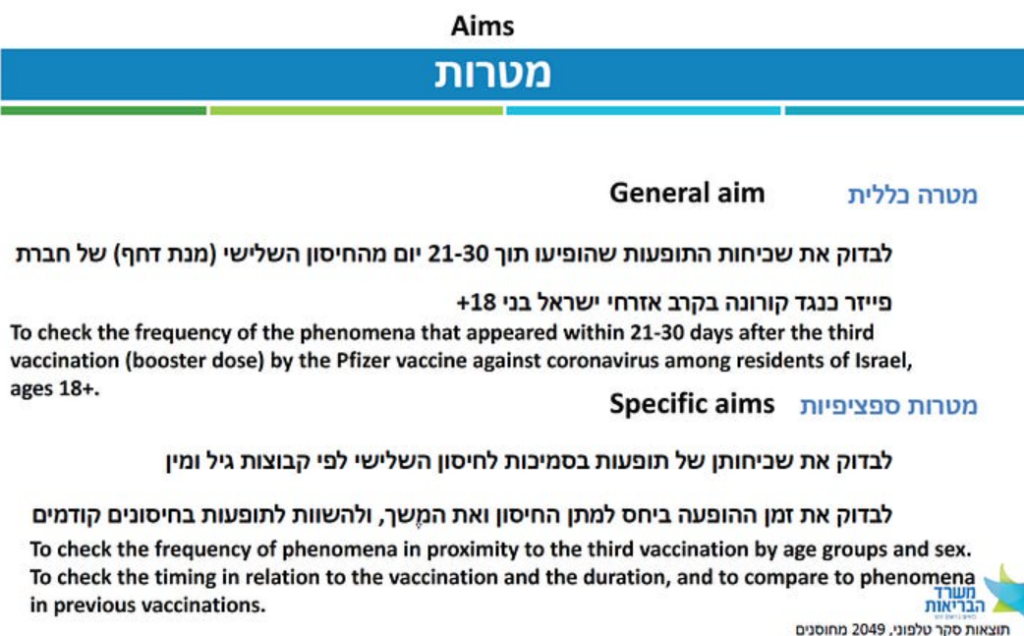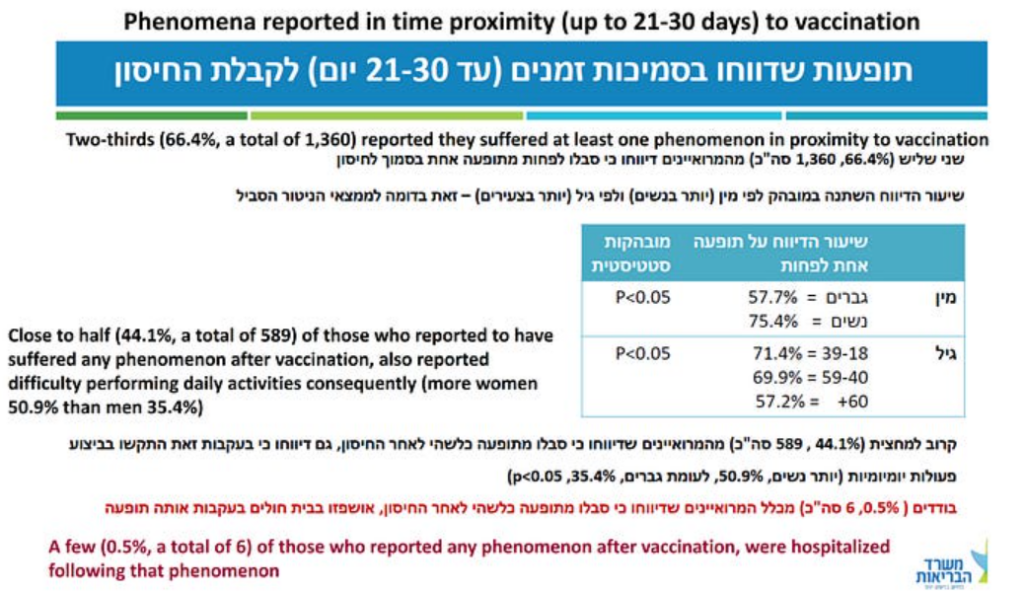by Dr Eyal Shahar, Daily Sceptic:

Downplaying. That has been a handy weapon against anything that threatened the official Covid narrative. Downplaying sceptical voices, downplaying uncertainties, downplaying contradictory data.
I recently described a typical example of the latter from Denmark. Here is another one, from Israel, which gives us a dual opportunity: first, to look at the rate of significant adverse events after the booster dose, as reported in a Government-initiated survey. Second, to observe the language the anonymous authors used to describe the data. Released long ago but not published in a medical journal (yet?), the summary was written in Hebrew and contained 26 slides. I have tried to offer below a precise translation of the text.
TRUTH LIVES on at https://sgtreport.tv/
The topic of the survey is called “reported phenomena”, which is not a complete phrase for “reported side-effects”, since, just like in English, an adjective is usually added to indicate the presumed link to a drug or a vaccine.
The authors are aware of under-reporting of side-effects, since they state “it appears that there is under-reporting”, though it is not clear how they infer that from reported data.
The aims of the survey are clearly stated (Figure 1). In brief, it was a random sample from the database of the Ministry of Health, excluding people without a listed phone number (understandable) and those who had had Covid (why?). Participants were vaccinated 21-30 days before a structured phone interview, conducted 2-3 months into the booster campaign.

Slightly over 2,000 people completed the interview, evenly split by sex. I am not sure why the sample size was not much larger, say, 20,000, closer to the vaccine trials. Lack of importance of the topic? Lack of resources in a country that served as a Pfizer laboratory? Downplaying unfavourable rates as imprecise (due to a small sample)?
Sampling ensured three equal-size age groups, which means that the age distribution of the sample did not necessarily match the age distribution of the vaccinated population. Although age-specific rates were sometimes presented, a weighted rate for the entire population was not.
Two to three months later, a follow up interview was conducted with 45 of 59 women who reported changes in menstruation after the booster. We’ll return to this part later.
Survey results are influenced not only by reporting accuracy but also by the response rate, which can be defined in more than one way. It was around 50% by one definition.
To estimate a range for the rate of selected side-effects, I will make two opposite assumptions about non-participants, which favour the vaccine. The first one is extreme.
- No side-effects would have been reported by non-participants, so any observed frequency should be divided by 2. You may also view this ‘correction’ as accounting for coincidental events.
- Unobserved rates in non-participants would have been identical, so any observed frequency is correct.
I am excluding the possibility that non-participants would have reported side effects at higher frequency than participants, again to favour the vaccine (a conservative approach).
A short preamble before showing data: vaccines are given to mostly healthy people who do not present themselves as care-seeking patients. Therefore, the standards for ‘safe’ are much more stringent than those for treatment of sick patients. In either case, Primum non nocere (first, do no harm) should be a governing principle.
Now, the data.
First, a vaccinee should have been lucky to escape side-effects – two-thirds reported at least one (Figure 2) – some of which have been classified by official voices as reactogenicity. Occasionally, that was a promotional public health message for Covid vaccines: the side-effects mean that the vaccine is working! For some reason, it has never been a promotional message for the flu vaccine.

In almost 30% of the sample (589 out of 2,049), or about 15% under the most conservative assumption, the side-effect was severe enough to have caused difficulty in daily activities. Read the last sentence again and imagine that the culprit was a new mRNA-based shot for flu rather than Covid. Going grocery shopping? Get your flu shot here for free and a good chance to spend a few days in bed, or off work!
More important, hospitalisation after vaccination should be extremely rare, perhaps in the single-digit range per million or so, or no more than one per 100,000. That used to be called a safe vaccine. The rate in this sample was six per 2,049 or 150-300 per 100,000 (my conservative range) – hundreds of times higher than for a safe vaccine.



